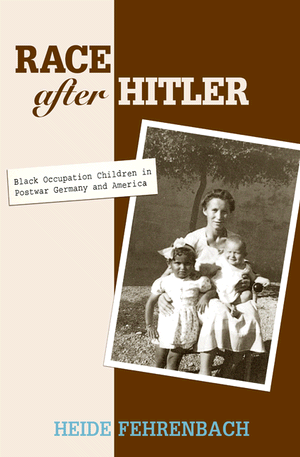Race after Hitler: Black Occupation Children in Postwar Germany and America |
Race after Hitler: Black Occupation Children in Postwar Germany and America
Princeton University Press
2005
288 pages
6 x 9, 17 halftones, 1 line illustration, 2 maps
ISBN13: 978-0-691-13379-9
Heide Fehrenbach, Presidential Research Professor of History
Northern Illinois University
When American victors entered Germany in the spring of 1945, they came armed not only with a commitment to democracy but also to Jim Crow practices. Race after Hitler tells the story of how troubled race relations among American occupation soldiers, and black-white mixing within Germany, unexpectedly shaped German notions of race after 1945. Biracial occupation children became objects of intense scrutiny and politicking by postwar Germans into the 1960s, resulting in a shift away from official antisemitism to a focus on color and blackness.
Beginning with black GIs’ unexpected feelings of liberation in postfascist Germany, Fehrenbach investigates reactions to their relations with white German women and to the few thousand babies born of these unions. Drawing on social welfare and other official reports, scientific studies, and media portrayals from both sides of the Atlantic, Fehrenbach reconstructs social policy debates regarding black occupation children, such as whether they should be integrated into German society or adopted to African American or other families abroad. Ultimately, a consciously liberal discourse of race emerged in response to the children among Germans who prided themselves on—and were lauded by the black American press for—rejecting the hateful practices of National Socialism and the segregationist United States.
Fehrenbach charts her story against a longer history of German racism extending from nineteenth-century colonialism through National Socialism to contemporary debates about multiculturalism. An important and provocative work, Race after Hitler explores how racial ideologies are altered through transnational contact accompanying war and regime change, even and especially in the most intimate areas of sex and reproduction.
Table of Contents
- List of Illustrations
- Acknowledgments
- Introduction: Democratizing the Racial State: Toward a Transnational History
- Chapter One: Contact Zones: American Military Occupation and the Politics of Race
- Chapter Two: Flaccid Fatherland: Rape, Sex, and the Reproductive Consequences of Defeat
- Chapter Three: “Mischlingskinder” and the Postwar Taxonomy of Race
- Chapter Four: Reconstruction in Black and White: The Toxi Films
- Chapter Five: Whose Children, Theirs or Ours? Intercountry Adoptions and Debates about Belonging
- Chapter Six: Legacies: Race and the Postwar Nation
- Abbreviations of Archives Consulted
- Notes
- Select Bibliography
- Index
THE MILITARY occupation of Germany by American troops elicited two striking responses that were organized around irony and issues of race. One came from Germans, who noted with incredulity and derision that they were being democratized by a nation with a Jim Crow army and a host of anti-miscegenation laws at home. The second came from African American GIs who, in their interactions with Germans, were stunned by the apparent absence of racism in the formerly fascist land and, comparing their reception with treatment by white Americans, experienced their stay there as unexpectedly liberatory. Both responses criticized the glaring gap between democratic American principles and practices; both exposed as false the universalist language employed by the United States government to celebrate and propagate its political system and social values at home and abroad. Yet both also suggested the centrality of intercultural observation and exchange for contemporaries’ experience and understanding of postwar processes of democratization…
Read Chapter One in HTML or PDF.
Tags: Afro-Germans, Germany, Heide Fehrenbach, Nazi Germany, Princeton University Press, World War II